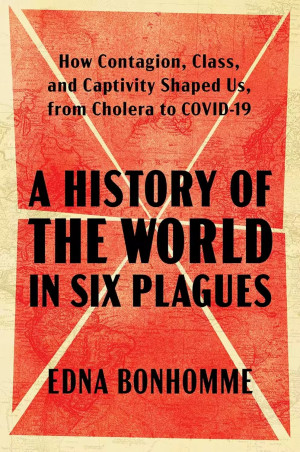Captivity accelerates contagion.
From French slave ships to modern border camps, confinement supercharges outbreaks.

Book summary
by Edna Bonhomme
How contagion, class, and captivity shaped us—from cholera to Covid
Bonhomme ties cholera to Covid-19, showing who gets sick and why
Topics
Read this book by focusing on one plague chapter at a time, noting the connections Bonhomme draws between historical epidemics and modern health inequities. Pay special attention to how she frames epidemics as political events rather than biological flukes. Use the book's structure to understand the different forms of structural violence across time periods. The book works best when you read it as both historical analysis and contemporary social commentary.
Things to know before reading
Understand that Bonhomme approaches epidemics through the lens of structural violence and social justice rather than traditional medical history. Be prepared for challenging content about colonialism, slavery, and systemic inequality. Familiarity with basic public health concepts will help but isn't required—the book provides sufficient context. This is not a neutral historical account but an argument about how power structures shape disease outcomes.
Historian Edna Bonhomme profiles six defining outbreaks—cholera, yellow fever, tuberculosis, typhus, HIV/AIDS, and Covid-19—to show how empire, prisons, plantations, and refugee camps turned microbes into mass-death events. Instead of a pathogen-centered narrative, she foregrounds the enslaved people, colonized workers, and incarcerated migrants who bore the brunt and organized care.
Each plague illustrates a different arm of structural violence.
From French slave ships to modern border camps, confinement supercharges outbreaks.
Authorities repeatedly scapegoated marginalized groups instead of fixing sanitation.
Midwives, nurses, and grassroots health workers kept communities alive when empires would not.
Ready to continue? Launch the Readever reader and keep turning pages without paying a cent.
The book equips health communicators and organizers with stories that connect infrastructure neglect to pathogen spread. Bonhomme blends archival research with reportage from Guantánamo, West African Ebola wards, and Mediterranean detention centers so you can argue for structural fixes with historical receipts.
Key idea 1
From French slave ships to modern border camps, confinement supercharges outbreaks.
Bonhomme draws lines between 18th-century holds packed with cholera carriers and 21st-century detention facilities where Covid ripped through detainees. The design of prisons and camps, not individual choices, determines exposure.
Remember
Key idea 2
Authorities repeatedly scapegoated marginalized groups instead of fixing sanitation.
Whether it was immigrants in Gilded Age New York or queer communities during the AIDS crisis, officials weaponized stigma to avoid investing in sewers, hospitals, or harm reduction. Bonhomme spotlights activists who fought back with data and mutual aid.
Remember
Key idea 3
Midwives, nurses, and grassroots health workers kept communities alive when empires would not.
From Haitian women boiling water for cholera patients to ACT UP volunteers tracking drug trials, Bonhomme shows that marginalized caregivers innovate under pressure—often long before governments follow suit.
Remember
Public health professionals building equity-centered preparedness plans.
Historians and educators teaching colonialism or medical humanities.
Activists linking carcerality, climate, and health justice.
Edna Bonhomme is a Berlin-based historian of science, writer, and organizer whose scholarship examines epidemics, memory, and liberation. Her essays have appeared in The Atlantic, The Guardian, and Journal of the History of Medicine and Allied Sciences.
Build your personalized reading stack
Download full-length ePubs in one click with personal cloud storage.
Blend AI-guided insights with tactile note-taking to accelerate reflection.
Follow curated reading journeys tailored to your goals and time budget.
Sync highlights across devices so lessons stick beyond the page.
Sign in to Readever to keep reading with AI guidance, instant summaries, and synced notes.
Start reading A History of the World in Six Plagues for free and unlock personalized book journeys with Readever.